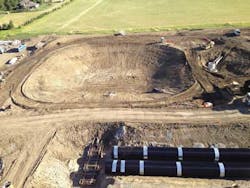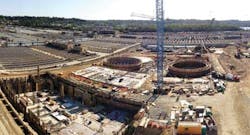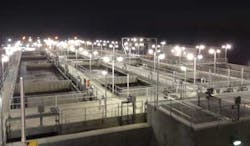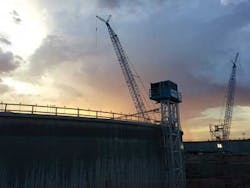The pace of construction in the municipal water industry has been slower in 2012 compared with 2011, in part because of a combination of the down economy and an end to the federal stimulus program, said Ken Simonson, Chief Economist with the Associated General Contractors of America (AGC).
Simonson tracks construction spending in a wide variety of market segments. He publishes a weekly Data Digest newsletter reporting on trends in the construction market. He noted that August data from the Census Bureau, released on October 1, showed water supply construction spending in August 2012 was down 12 percent from August 2011.
"When comparing the eight months of 2012 against the first eight months of 2011 we still saw a drop of 6.0 percent," Simonson said. "Sewage and waste disposal has been running about level. For the August to August comparison, it was plus 0.7. But the eight month comparison was minus 0.9 percent. So, call it even.
"Frankly I expect more of the same. I think that water supply construction is certainly being hurt by the drop in federal funding, tight local budgets and a still depressed home building market."
The American Recovery and Reinvestment Act of 2009 helped stimulate construction in the water market, along with increased appropriations to the State Revolving Loan Fund that year.
"Both of those pretty much got used up in 2011, and we're still seeing the aftermath of falling construction spending," Simonson said. "Obviously some of these projects take two to three years to finish construction, and there are still some of the projects going on. As they wrap up, fewer new projects are getting started."
On the stormwater and collections side of the market, a number of cities are working through a decade-long process of dividing up their combined stormwater systems. In many cases these are multi-billion dollar projects. Simonson pointed to his hometown, the District of Columbia, which expects to spend well over $2 billion over a period of years.
"These massive projects are a considerable boost and steadying influence on the sewer construction category," Simonson said. "Nevertheless, I don't expect to see a pickup in sewer construction in 2013.
"The drinking water side may do a little better next year because both single and multi-family housing are picking up from their lows of 2011, and we will have a good year in 2013," he said. However, the general trend has been to build close in, instead of projects expanding into the suburbs that would drive water line extensions or require new treatment capacity.
Long term, Simonson said the US economy and population will continue to grow albeit at a slow pace.
"As a result there will be growing demand for new capacity and a continued need to replace and modernize what has been sitting there, in some cases for a century or more," he said.
"The fundamentals look good, but the question remains: Where will the funding come from? To the extent that general revenues are important, utilities will respond to the overall economy. To the extent utilities are tied specifically to rate payers, the overall trend should be favorable.
"For water, I think 2013 will be another year of hardship. For sewage, another year of standing pat. Beyond 2013, we will see a gradual improvement from the current dreary situation."
Construction spending data from the Census Bureau may be found here: www.Census.gov/constructionspending
Hyalite/Sourdough WTP
Blue Plains Facility Upgrade
With a capacity of 370 mgd and a peak capacity of more than a billion gallons per day, the Blue Plains Advanced Wastewater Treatment facility, operated by the District of Columbia Water and Sewer Authority (DC Water), is in the midst of a $208 million upgrade to the biosolids management process.
The project includes the world's largest Cambi thermal hydrolysis process (THP) system, and the first Cambi THP system in the United States. Looking to maximize available resources and reduce its carbon footprint, DC Water is implementing an upgrade that consists of four individual projects: site preparation, main process train (MPT), combined heat and power (CHP) and final dewatering. CDM Smith, as an equal, joint-venture partner, is providing design-build services for the MPT project, which will be developed using a building information model and 3D/4D technology. The new, upgraded main process train project will reduce trucking costs and reduce energy demands from the grid.
Fort Worth Westside Water Treatment Plant |
McCarthy Building Companies recently completed the $47 million Fort Worth Westside Water Treatment Plant. The new water treatment facility has an initial treatment capacity of 12 mgd and is expandable to meet the future needs of western Fort Worth.
The facility will treat raw water from the Tarrant Regional Water Board's 90-inch raw water main that connects Eagle Mountain Lake with the East Texas water supply in Cedar Creek and Richland-Chambers reservoirs. It will then distribute the treated water to the growing west side of Fort Worth.
The water treatment facility utilizes advanced treatment processes including low pressure membrane microfiltration and ozone gas. Also included in the facility are an operations building, filter complex, wash water recovery basins, a recycle pump station, a 2.5 million gallon ground storage tank, a high-service pump station, an ozone chemical building and an electrical building.Orange County GWRS Expansion
Completion of the Black & Veatch-designed expansion in the fall of 2014 will bring total production of the GWRS to 103,000 acre feet per year (AFY) — enough water for 850,000 people. McCarthy Building Companies Inc. is the construction contractor. The overall project cost is $142.7 million with the construction portion being $115.1 million.
The GWRS — a joint project of the OCWD and the Orange County Sanitation District — produces water that exceeds all state and federal drinking water standards, using a three-step advanced treatment process to purify wastewater that otherwise would have been discharged into the Pacific Ocean. It enhances existing water supplies by providing a reliable, high-quality source of water to recharge the Orange County Groundwater Basin and protect it from further degradation due to seawater intrusion.









